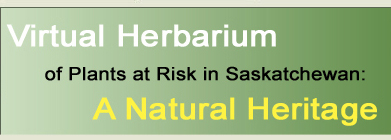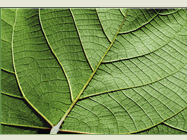|
| Eleocharis nitida
Fern. |
|
| |
| TAXONOMY |
| |
| Family: |
Cyperaceae |
| Genus: |
Eleocharis |
| |
| Species Synonyms: |
none |
| Common Names: |
quill spikerush
neat spike-rush |
| |
| DISTRIBUTION |
| |
| Canada: |
British Columbia – southwestern Alberta,
northeastern Saskatchewan – Ontario – Newfoundland – Nova
Scotia |
| Saskatchewan: |
northeastern Saskatchewan; Stony Rapids –
Wollaston Lake – Pasquia Hills |
| Ecoregion: |
Boreal Transition, Churchill River Upland, Athabasca
Plain, Tazin Lake Upland |
| |
| HABITAT |
| |
| Saskatchewan: |
moist shores, pond edges, wet depressions, and
fens |
| Associated Species: |
black spruce, fowl mannagrass, golden sedge, horsetails,
jack pine, ticklegrass |
| |
| RARITY STATUS |
| |
Provincial
Status According
to Harms (2003): |
Threatened |
| Nature Conservancy
Status: |
G3G4 S2 |
Saskatchewan
Species at
Risk Status: |
None |
| COSEWIC Status:
|
None |
| |
| Quill spikerush
is threatened in Saskatchewan because it is rare or uncommon and most local
populations are small. No immediate threats are known or anticipated for
this species. |
| |
| SPECIES
DESCRIPTION |
| |
| Height: |
2 – 15 cm |
| Roots: |
rhizome, 0.3 – 0.5 mm thick, hard, scales
membranous to papery or fibrous |
| Stems: |
perennial, mat-forming, 4-angled, hair-like |
| Leaves: |
blade bearing leaves absent; bladeless sheaths
straw-coloured to reddish at top, lower part greenish or straw-coloured,
membranous, tip often red and entire |
| Inflorescence: |
spikelet terminal, solitary, erect |
| Spikelets: |
1 – 4 mm long, ovoid; scales spreading in
fruit, 5 – 30, 8 per mm of spikelet axis, oval, tip rounded and entire,
medium to dark brown, midrib pale or greenish |
| Flowers: |
perianth bristles absent; stamens 3, anthers yellow;
styles 3-branched |
| Achenes: |
achenes persistent after scales fall, three-angled,
angles evident, dark yellow-orange or brown; swellings at base of style
brown, greatly depressed, not well-developed |
| |
| ELEOCHARIS
KEY FOR SPECIES FOUND IN SASKATCHEWAN |
| |
| 1 Achenes with 9 – 13 longitudinal
rows of horizontal ridges between prominent longitudinal ridges and achene
angles; spikelets with lowest scale always subtending a flower; stems to
1.5 mm wide |
E. acicularis |
| 1 Achenes without long rows of horizontal
ridges; lowest scale subtending a flower or empty; stems to 5 mm wide |
2 |
| |
|
2 Swelling at tip of achene conical,
confluent with achene; stigmas 3
|
3 |
| 2 Swelling at tip of achene well-differentiated;
stigmas 2 or 3 |
4 |
| |
|
| 3 Spikelets to 3 mm long, internodes
equal in thickness and length throughout the spikelet; scales 5 –
500 per spikelet, green or pale brown; stems < 10 cm tall; rhizome lacking
a bulb |
E. parvula |
| 3 Spikelets to 7 mm long, proximal
internodes thicker and shorter than internodes in the middle of the spikelet;
scales 4 – 12 per spikelet, tinged with purple or brown; stems to
40 cm tall; rhizomes bulbous |
E. quinquefolia |
| |
|
| 4 Styles 2-fid; achenes convex |
5 |
| 4 Styles 3-fid; achenes three-sided |
7 |
| |
|
| 5 Tufted annuals, roots fibrous; achenes
green, straw-coloured, or black; anthers 0.2 – 1 mm long |
E. engelmannii |
| 5 Perennials with rhizomes or runners;
achenes yellow to dark brown; anthers 1 – 2.5 mm long |
6 |
| |
|
| 6 Tip of uppermost leaf sheath with
distinct tooth on all or some stems; base of spikelet with single empty
scale nearly enclosing stem |
E. erythropoda |
| 6 Tip of distal leaf sheath without
distinct tooth on all stems; base of spikelet with 2 or 3 firm, empty scales |
E. palustris |
| |
|
| 7 Achenes biconvex (or < 1/3 of
achenes trigonous); tufted annuals; spikelets never proliferous |
E. engelmannii |
| 7 Achenes trigonous; annuals or perennials,
rhizomatous or stoloniferous; spikelets may be proliferous |
8 |
| |
|
| 8 Achene surface honey-comb netted;
swelling at tip of achene broader than high; stems to 90 cm tall |
E. elliptica |
| 8 Achene surface minutely wrinkled
or roughened but not netted; swelling at tip of achene longer than broad;
stems to 40 cm tall |
9 |
| |
|
| 9 Spikelets < 5 mm long; stems
4-angled and capillary |
E. nitida |
| 9 Spikelets to greater than 1 cm long;
stems flat and wiry |
E. compressa |
|






